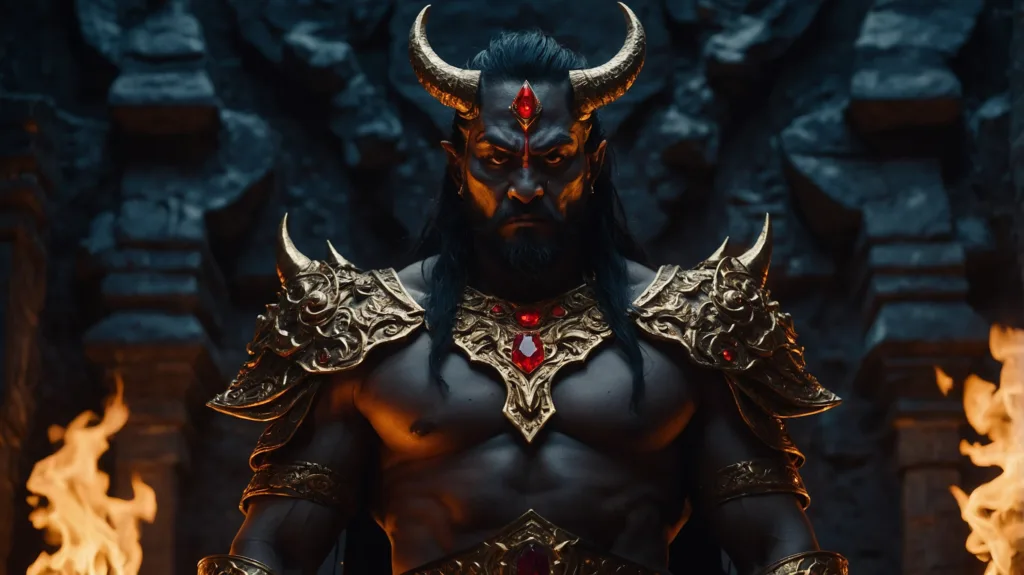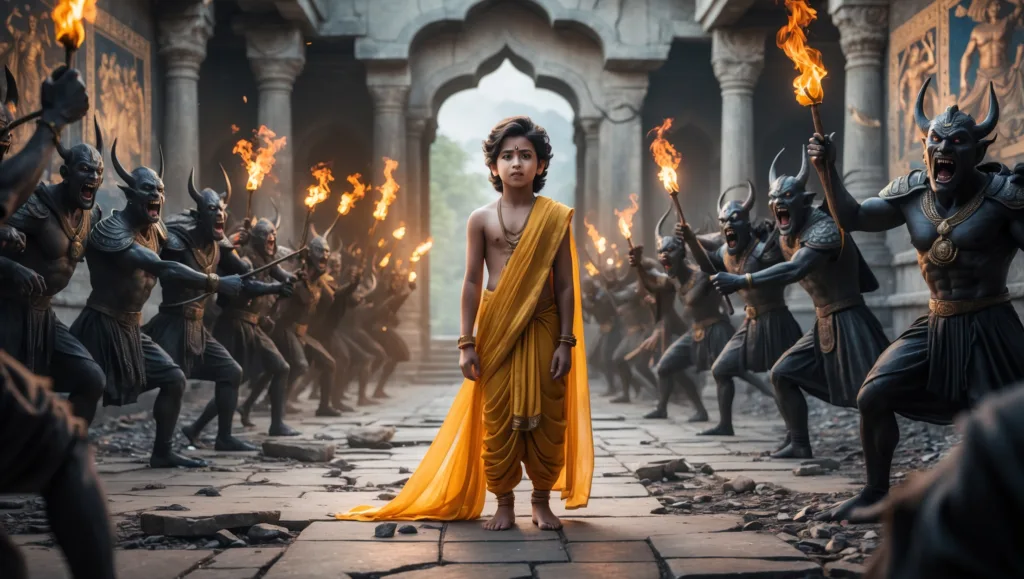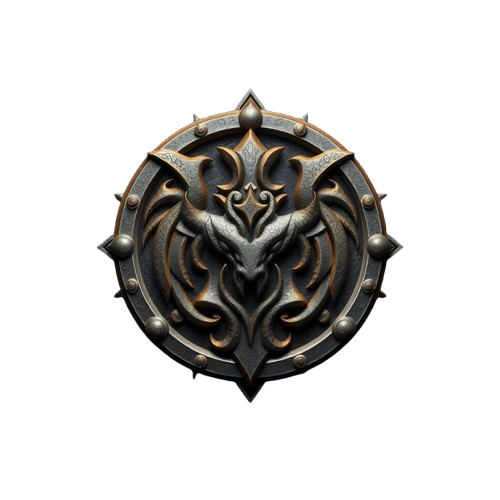Introduction
In the grand tapestry of Hindu mythology, few tales are as powerful, dramatic, and spiritually profound as that of Lord Narasimha and his devotee, Prahlad. This timeless story, woven into the fabric of the Bhagavata Purana, Vishnu Purana, and various Puranic texts, symbolizes the eternal triumph of good over evil, faith over tyranny, and divinity over demonic pride. Lord Narasimha, the fourth avatar of Vishnu, takes a half-man, half-lion form to uphold Dharma and fulfill a divine promise. His emergence is not merely a tale of supernatural intervention but a deeply symbolic event carrying lessons on faith, devotion, humility, and cosmic justice.
This blog explores the 8000-word retelling and analysis of the legend of Lord Narasimha and Prahlad, encompassing its historical, philosophical, and spiritual dimensions. Through narrative storytelling and scriptural context, we will unravel the depth and relevance of this legend in the modern world.
Origins of the Legend
The Cosmic Balance and Avatars of Vishnu
In Hindu cosmology, Lord Vishnu is the preserver and protector of the universe. Whenever evil threatens to disrupt the cosmic balance, Vishnu incarnates in various forms, or avatars, to restore Dharma (righteousness). Narasimha is the fourth of these ten primary avatars (Dashavatara).
Each avatar arises out of a specific necessity, and the form of Narasimha is particularly unique due to its hybrid nature. It is the only avatar that defies categorization into animal or man, which is central to the story’s resolution.
The Rise of Hiranyakashyapu

The legend begins with two powerful Asura brothers: Hiranyaksha and Hiranyakashyapu. Born to sage Kashyapa and Diti, they were mighty beings driven by hatred toward Vishnu due to a prior cosmic conflict. Hiranyaksha was slain by Lord Vishnu in his Varaha (boar) avatar when he threatened to drown the Earth in the cosmic ocean.
Grief-stricken and enraged, Hiranyakashyapu vowed revenge against Vishnu. Determined to become invincible, he performed severe penance (tapasya) to please Brahma, the creator god. Moved by his austerity, Brahma offered him a boon.
The Boon of Invincibility
Hiranyakashyapu asked for a boon that would make him virtually immortal. While Brahma could not grant literal immortality, he cleverly asked:
- Not to die indoors or outdoors
- Not during day or night
- Not on earth or in the sky
- Not by any weapon
- Not by any human or animal
Brahma granted the boon, and Hiranyakashyapu, believing himself invincible, began a reign of terror. He declared himself as God and demanded worship from all.
Prahlad: The Devotee Son

The Birth of Prahlad
Ironically, Hiranyakashyapu’s own son, Prahlad, emerged as a devout follower of Lord Vishnu. From an early age, Prahlad displayed immense spiritual wisdom, humility, and unwavering devotion to the Supreme Being.
Despite being born in a family of Asuras, Prahlad’s innate purity and bhakti (devotion) set him apart. It is believed that Narada Muni, the sage of the gods, blessed Prahlad while he was still in his mother’s womb by reciting Vishnu’s glories.
The Trials of Faith
Prahlad’s devotion infuriated Hiranyakashyapu. Unable to accept that his own son worshipped his mortal enemy, Vishnu, he subjected Prahlad to relentless torture:
- He was thrown into a pit of venomous snakes.
- Pushed off a mountain cliff.
- Trampled by elephants.
- Poisoned and starved.
- Burned in fire with Holika, the demoness.
But in every instance, Vishnu protected Prahlad. This divine protection further deepened Prahlad’s devotion and incited Hiranyakashyapu’s wrath.
The Final Confrontation
The Challenge
After exhausting all means to kill his son, Hiranyakashyapu confronted Prahlad in his royal court. Enraged, he asked:
“Where is your Vishnu now? Is he in this pillar?”
Prahlad responded calmly, “He is everywhere, even in this pillar.”
Narasimha Appears
Hiranyakashyapu struck the pillar with his mace, and to the astonishment of all, it split open with a thunderous roar. From within emerged Lord Narasimha, in a terrifying form:
- The head of a lion
- The body of a man
- Fierce eyes and golden mane
- Claws that gleamed like lightning
Narasimha was neither man nor animal, and he had emerged at twilight – neither day nor night. He grabbed Hiranyakashyapu and dragged him to the threshold of the palace – neither indoors nor outdoors.
There, placing him on his lap – neither earth nor sky – Narasimha tore open his chest with his claws, thus killing the tyrant without using any weapon.
Divine Justice Fulfilled
This act fulfilled all the conditions of Brahma’s boon, proving that divine intelligence transcends the arrogance of mortals. Narasimha did not just punish evil but reaffirmed the power of devotion and Dharma.
The Aftermath
Narasimha’s Fury
Even after killing Hiranyakashyapu, Narasimha’s rage did not subside. His divine wrath shook the cosmos, and none dared to approach him. The gods, including Brahma and Shiva, were unable to calm him.
Prahlad’s Prayer
Finally, it was Prahlad who stepped forward and sang hymns of devotion (the Narasimha Stuti). With folded hands and tears of surrender, he prayed:
“O Lord, I seek no boons. Just let me always remember You.”
Pleased with Prahlad’s humility, Narasimha calmed down, embraced him, and offered him blessings.
Prahlad’s Rule
With his father’s death, Prahlad ascended the throne and ruled righteously. His kingdom became a haven of peace, prosperity, and spiritual wisdom.
Symbolism and Philosophical Insights
Narasimha: The Ultimate Protector
Narasimha represents the force of divine protection. His form is a reminder that when devotion is pure and unwavering, God will transcend all limitations to uphold it.
Prahlad: The Ideal Devotee
Prahlad symbolizes innocence, courage, and unshakable faith. Despite immense suffering, he never wavered in his devotion. His story is a model for spiritual aspirants.
Hiranyakashyapu: The Ego
Hiranyakashyapu stands for ego, arrogance, and blind ambition. His demise reflects the inevitable downfall of those who reject Dharma and divine truth.
The Pillar: Omnipresence of God
The pillar from which Narasimha emerged signifies God’s presence in all things – animate and inanimate. God does not need a place to reside. He is everywhere.
Relevance Today
In today’s world of moral dilemmas and rising materialism, the story of Narasimha and Prahlad holds timeless relevance. It teaches:
- Faith can move mountains.
- True devotion is fearless.
- Arrogance, even when cloaked in power, leads to downfall.
- God protects the righteous in mysterious ways.
Celebrating Narasimha Jayanti
Narasimha Jayanti is observed on the 14th day of the bright half of Vaishakha month (April-May). Devotees fast, pray, and read the story of Narasimha to seek protection and blessings.
Temples dedicated to Narasimha include:
- Ahobilam (Andhra Pradesh)
- Simhachalam (Visakhapatnam)
- Sholingur (Tamil Nadu)
- Devarayanadurga (Karnataka)
Conclusion
The legend of Lord Narasimha and Prahlad is more than just a mythological tale. It is a beacon of hope, a lesson in unwavering faith, and a symbol of divine justice. Whether you see it as a historical episode or spiritual allegory, its message remains ever-relevant: Where there is true devotion, divine protection shall follow.
Let us remember that amidst the chaos of the world, the voice of Prahlad still echoes – calm, faithful, and fearless – reminding us to hold fast to truth and righteousness.
Jai Narasimha!
For more interesting mythology facts visit https://www.youtube.com/@Mythoexplorers
For more interesting mythology facts visit https://www.facebook.com/profile.php?id=61577166993705
For more interesting mythology facts visit https://www.instagram.com/mythoexplorers/
To know more about Hindu Mythology read the blog articles https://mythfacts.blog/category/hindu-mythology/

